What’s this web page all about?
We carried out a detailed survey of the Purple Hairstreak (N.quercus) butterfly in Kent, but we still need your help.
In 1994, the species was recorded from 46 tetrads in Kent and was clearly under recorded. A new survey was started in 1995 with particular emphasis on egg searching during the winter months. The result was a total of 518 tetrads by March 2004 from just our own survey. That’s an increase in coverage of 472 tetrads! Add to these the records from fellow observers, and the total now stands at 528. Many of these records were the result of winter egg searches.
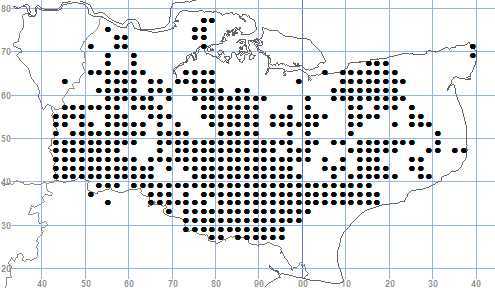
Purple Hairstreak Kent distribution map (as of year 2005)
How To Search For Eggs
Searching for eggs is not as hard as you might think. It is best undertaken from end of December through to the beginning of April. The female hairstreak is fairly catholic in her choice of tree but a few points will help narrow down the field a little.
Eggs may be laid on all varieties of oak but there is a definite preference for the Pedunculate Oak (Quercus robur)
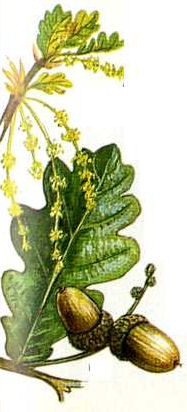
Pedunculate Oak (Quercus robur)
Often called the Common or English Oak. Short leaf stem, long acorn stem.
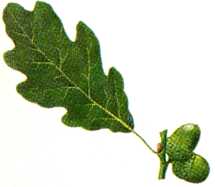
Sessile Oak (Quercus petraea)
Long leaf stem, short acorn stem
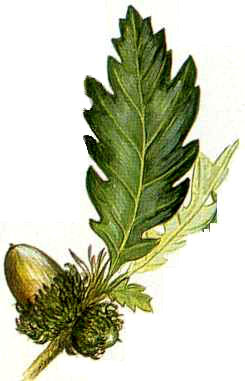
Turkey Oak (Quercus cerris)
Hairy buds and acorn cups
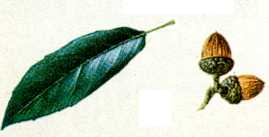
Holm Oak (Quercus ilex)
Evergreen leaves
Equipment
A walking stick to pull down higher branches
A good quality hand lens (X6 magnification)
Selecting Your Tree
When choosing a tree to investigate, it’s a good idea to spend a few moments picking amongst the leaf litter to establish what variety you are looking at. Robur and petraea offer the best chance of success and should be chosen in preference to cerris or ilex. Look for old trees with little new growth and particularly trees with twisted and gnarled twigs. South facing branches in sheltered areas will yeald the best results with many eggs laid within 2m of the ground but don’t ignor the north facing aspect as this can also be very productive. Almost any tree can support a colony and we have found eggs on trees less than ten years old. Single trees in a hedgerow are always worth a search although they may seem isolated from any woodland complex. It must be remembered that these trees were probably part of a much more mature hedgerow than remains today and would have formed a good habitat, connecting various woodlands together. As the trees died or were cropped, the colonies would have been isolated to the remaining trees where they can exist for many years without any apparent degredation through in-breeding.
Typical sittings of eggs

Egg on Quercus ilex
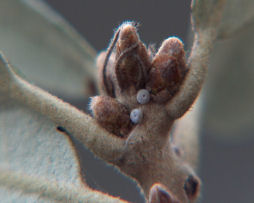
Egg on Quercus ilex

Egg on Quercus robur
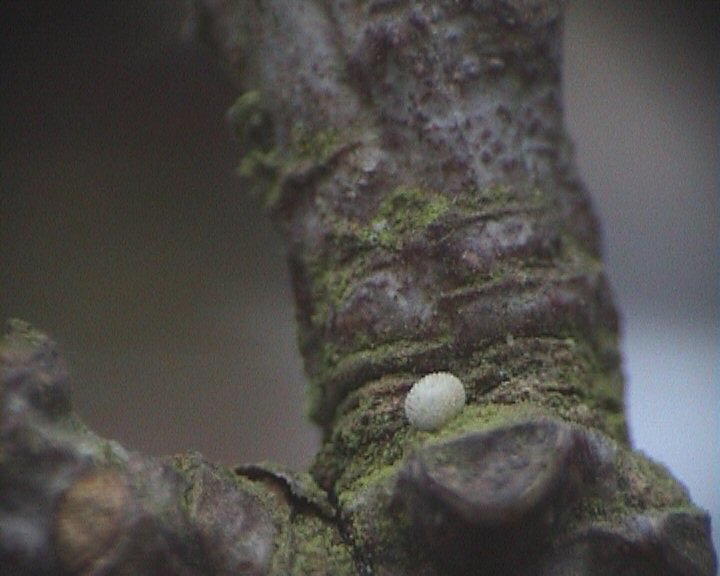
Egg on Quercus robur
Once you have located what you believe to be an egg, take a few moments with your hand lens to confirm that it is indeed a hairstreak egg. There are several species of moth that lay eggs in a similar position and some confusion may result but the lens will soon sort out any doubts. Quercus eggs are beautifly sculptured and resemble tiny sea urchins and are quite unlike any moth eggs likely to be encountered during the winter months and these are usually heavily or finely ribbed and somewhat smaller than quercus.
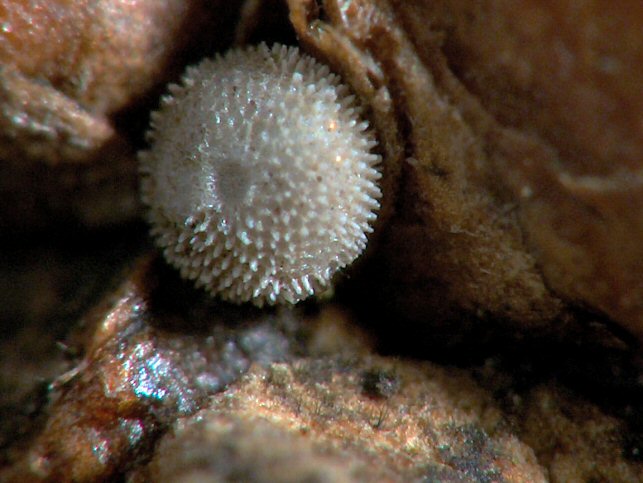
Magnified quercus egg
Having found your first egg, look around for neighbouring oaks that may well contain a colony. Trees on the corner of woods are particularly productive and any hedgerows running off from the wood will usually have an oak or two within them where quercus will undoubtedly be thriving. After a little practice and, above all, success, you will soon be able to spot a likely tree from several hundred metres and become more selective in your search.
Never ignore fallen branches. At least twenty tetrads were recorded by searching windblown branches within coppice woodland where the standard oaks were trimmed too high for conventional searching. Providing the branch fell after September, there is every chance that you will find up to a dozen eggs on one branch as the wind often takes out wood from the exposed canopy of the tree. These eggs, of course, will perish unless intervention takes place. Purple Hairstreaks can be reared with ease and released when the adults emerge and breeding methods are described below.
As winter gives way to spring, it is possible to continue your surveys by locating the small larvae. Searching begins in April and can continue into May, although the leaf development may obscure any sign as the season continues. The freshly emerged larvae bore a small hole in the developing bud, leaving a distinct entry aperture.
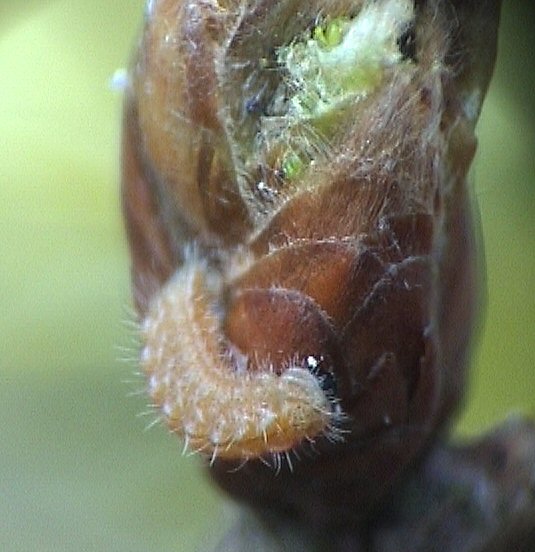
Quercus larva

Small bore hole in the developing bud, made by the freshly emerged larva
Late May and June can be productive for larvae searches but they can be surprisingly difficult to locate amongst the leaf and flower debris. Great care should be taken to avoid crushing the larva whilst searching. “Beating” the tree is often recommended for larvae searching but, in my experience, this is seldom productive as the larvae are very secure on the twig and one is left with a whole range of insects and moth larvae to be put back onto the tree. It is questionable whether this method has any real value when considering the conservation aspect.

Quercus larva (fully grown)
Rearing from lost eggs
Collect any eggs that you find on the fallen branch, leaving about 50mm of twig attached. Place them in the bottom of your refridgerator in a container covered with a piece of tissue. Damp the twigs occasionally to prevent them drying out and avoid the temptation to bring them out for study. At the end of March, remove the stock from the fridge and lay them out on a clean surface.
Using a good lens and a sharp scalpel, carefully cut the eggs from the twigs leaving them attached to a slip of bark. Take care, they are very small and can easilly fly off as they are cut free. Handle them with a very fine artist’s brush dipped in clean water. Place each egg, attached to its bark, on a sheet of white paper in the bottom of a suitable container about 2cm apart. Place the container back into the fridge.
With Spring fast approaching, the oak buds will be swelling and you should try to procure a selection of the most advanced twigs. Place them in water and ensure that they receive plenty of sunlight, a windowsill is probably the best place, and watch them carefully for the first signs of bud-burst. Pinch off all but the terminal bud.
When the buds show the first indication of movement, remove the eggs from the fridge and place them in a cool place. You will need to check them twice daily for any signs of hatching. The emerging larvae will be very small but should show up readily on the white paper. It’s as well to look at the egg itself to see if there is a hole in the crown as many larvae stay on the bark and can be difficult to spot. Using the artist’s brush, very carefully move the larvae onto the bursting buds. Be sure to place only one larva per bud as they tend to be canibalistic in the early stages and you may well end up with fewer than you think!
Within a few hours, the larvae will bore into the buds and the only sign of their existence will be a dusting of droppings below the buds. They will remain hidden for several days until the first moults are completed. Temperature will affect when they emerge to feed on the outside of the buds. These first days are crucial and the larvae will need to be monitored closely to ensure that they do no run out of food. It is all too easy for the bud to be hollowed out with little external damage and the larvae can soon starve. If needs be, new buds can be rested against the old ones and the larvae will transfer during darkness without any assistance. Take note that oak does not do well in water in the early stages and can dry out very quickly, so be viglilant.
You will need to be well organised in the early days to ensure that you always have sufficient food available and a constant supply of fresh twigs should be gathered and brought on in the windowsill. Once the larvae are large enough to feed on the emerging leaves, your troubles are mostly over. They can now be reared in any suitable container until large enough to pupate. When fully grown, the larvae will leave the twigs and begin to wander about. This is the time to line the container with dry moss and provide a few twigs for the emerging butterflies to climb onto to dry their wings. Keep the container in a cool place and check daily for any sign of emerging adults. If all goes well, you should have some adults to release back into the same location, preferably to the same tree, from where the eggs were found and you will have done your piece for conservation as well as learning more about the species.
Don’t be too disheartened if you fail, Nature sacrifices many more than you are likely to and, without your help, the eggs from the fallen branch would have certainly perished.

Male Quercus (Purple Hairstreak)
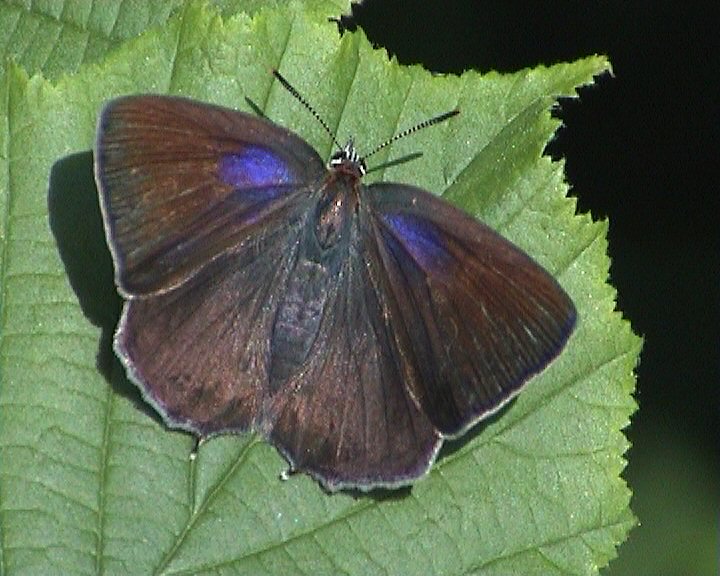
Female Quercus (Purple Hairstreak)
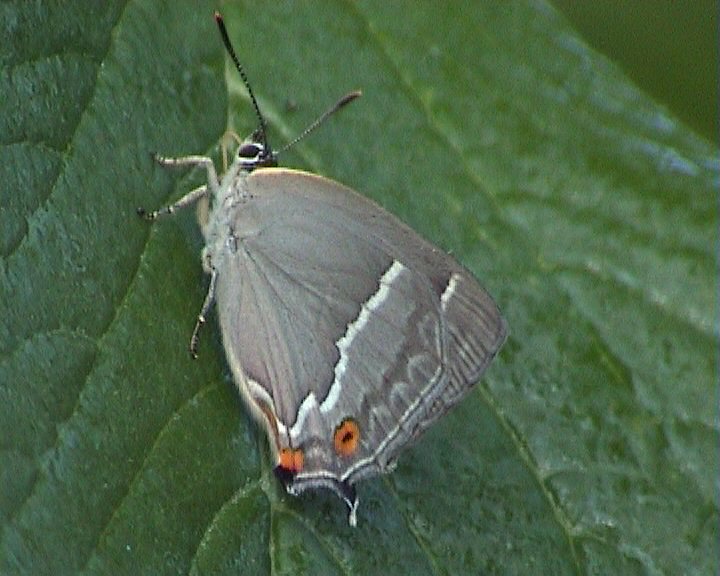
Quercus (Purple Hairstreak) Underside
Recording
It is most important to record where and when you find your eggs or adults and forward the details to our email address below. They will be entered onto our database and will be made available to the Butterfly Conservation for the National records. The information will also be available to all members from our Recording Officer.
You may be interested to know that The Millennium Atlas Of Butterflies In Britain And Ireland has just been published by Oxford University Press ISBN 0 19 850565 5 and is gives up-to-date information on the status of our butterflies throughout the UK.
Good hunting.
Website text and photos, by and © Peter Kirby
